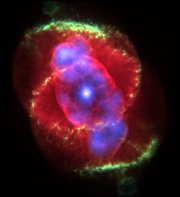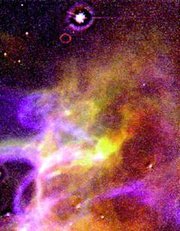Stellar evolution
|
|
In astronomy, stellar evolution is the sequence of changes that a star undergoes during its lifetime, the millions or billions of years during which it emits light and heat. Over the course of that time, the star will change radically.
Stellar evolution is not studied by observing the life cycle of a single star—most stellar changes occur too slowly to be detected even over many centuries. Instead, astrophysicists come to understand how stars evolve by observing numerous stars, each at a different point in its life cycle, and simulating stellar structure with computer models.
| Contents [hide] |
Birth
Triangulum.nebula.full.jpg
Stellar evolution begins with a giant molecular cloud (GMC). Most of the 'empty' space inside a galaxy actually contains around 0.1 to 1 particle per cm³, but inside a GMC, the typical density is a few million particles per cm³. A GMC contains 100,000 to 10,000,000 times as much mass as our Sun by virtue of its size: 50 to 300 light years across.
As a GMC orbits the galaxy, one of several events might occur to cause its gravitational collapse. GMCs may collide with each other, or pass through dense regions of spiral arms. A nearby supernova explosion can also be a trigger, sending shocked matter into the GMC at very high speeds. Finally, galactic collisions can trigger massive bursts of star formation as the gas clouds in each galaxy are compressed and agitated by the collision.
A collapsing GMC fragments as it collapses, breaking into smaller and smaller chunks. Fragments with masses of less than about 50 solar masses are able to form into stars. In these fragments, the gas is heated as it collapses due to the release of gravitational potential energy, and the cloud becomes a protostar as it forms into a spherical rotating object.
This initial stage of stellar existence is almost invariably hidden away deep inside dense clouds of gas and dust. Often, these star-forming cocoons can be seen in silhouette against bright emission from surrounding gas, and are then known as Bok globules.
Very small protostars never reach temperatures high enough for nuclear fusion to begin; these are brown dwarfs of less than 0.1 solar mass. They die away slowly, cooling gradually over hundreds of billions of years. The central temperature in more massive protostars, however, will eventually reach 10 million kelvin, at which point hydrogen begins to fuse into helium. The star begins to shine. The onset of nuclear fusion sets up a hydrostatic equilibrium in which energy released by the core prevents further gravitational collapse. The star then exists in a stable state.
Maturity
New stars come in a variety of sizes and colors. They range in spectral type from hot and blue to cool and red, and in mass from less than 0.5 to more than 20 solar masses. The brightness and color of a star depend on its surface temperature, which in turn depends on its mass.
A new star will fall at a specific point on the main sequence of the Hertzsprung-Russell diagram. Small, cool red dwarfs burn hydrogen slowly and may remain on the main sequence for hundreds of billions of years, while massive hot supergiants will leave the main sequence after just a few million years. A mid-sized star like the Sun will remain on the main sequence for about 10 billion years. Once a star expends most of the hydrogen in its core, it moves off the main sequence.
The middle years of a star's life

After millions to billions of years, depending on its initial mass, a star has exhausted all the hydrogen in its core. Larger and hotter stars consume their hydrogen much more rapidly than cooler and less massive ones. Once the core's ready supply of hydrogen is gone, nuclear processes there cease.
Without the outward pressure generated by these reactions to counteract the force of gravity, the outer layers of the star begin to collapse inward on the core. The temperature and pressure increase as during formation of the protostar, but now to even higher levels, until helium fusion begins at core temperatures of around 100 million kelvin.
The very hot core causes the outer layers of the star to expand enormously; the star becomes as much as 100 times larger than it was during its main sequence lifetime. It is now a red giant, and the helium burning phase lasts for a few million years. Almost all red giants are variable.
What happens next depends, once more, on the star's mass.
The later years and death of stars
Geriatric low-mass stars
What happens after a low-mass star exhausts its hydrogen is not directly known: the universe is around 13.7 billion years old, which is less time (by several orders of magnitude, in some cases) than it takes for the fuel to be exhausted. Current theory is based on computer modelling.
Some stars may fuse helium in core hot-spots, causing an unstable and uneven reaction as well as a heavy solar wind. In this case, the star will form no planetary nebula but simply evaporate, leaving little more than a brown dwarf.
But a star of less than about 0.5 solar mass will never be able to fuse helium even after the core ceases hydrogen fusion. There simply isn't a stellar envelope massive enough to bear down enough pressure on the core. These are the red dwarfs, such as Proxima Centauri, which live for hundreds of billions of years. When nuclear reactions eventually cease in their cores, they will continue to glow weakly in the infrared and microwave part of the electromagnetic spectrum for many billions of years.
Mid-sized stars

Once a medium-size star (between 0.4 and 3.4 solar masses) has reached the red giant phase, its outer layers continue to expand, the core contracts inward, and helium begins to fuse into carbon. The fusion releases energy, granting the star a temporary reprieve. In a Sun-sized star, this process will take approximately one billion years.
Helium burning reactions are extremely sensitive to temperature, which causes great instability. Huge pulsations build up, which eventually give the outer layers of the star enough kinetic energy to be ejected as a planetary nebula. At the center of the nebula remains the core of the star, which cools down to become a small but dense white dwarf, typically weighing about 0.6 solar masses, but only the size of the Earth.
White dwarfs
Main article: white dwarfs
White dwarfs are stable because the inward pull of gravity is balanced by the degeneracy pressure of the star's electrons. (This should not be confused with the electrical repulsion of electrons, but is a consequence of the Pauli exclusion principle.) With no fuel left to burn, the star radiates its remaining heat into icy space for many millions of years.
In the end, all that remains is a cold dark mass sometimes called a black dwarf. However, the universe is not old enough for any black dwarf stars to exist.
If the white dwarf's mass increases above the Chandrasekhar limit of 1.4 solar masses, then electron degeneracy pressure fails and the star collapses. Mass transfer in a binary system may cause such an increase in mass. This causes the white dwarf to be blasted apart in a type Ia supernova. These supernovae may be many times more powerful than the type II supernova marking the death of a massive star. Hence, no white dwarf more massive than 1.4 solar masses can exist; electron degeneracy pressure isn't strong enough.
If a white dwarf forms a close binary system with another star, hydrogen from the larger companion may accrete around and onto a white dwarf until it gets hot enough to fuse in a runaway reaction, although the white dwarf remains below the Chandrasekhar limit. Such an explosion is termed a nova.
Supermassive stars

After the outer layers of a star greater than five solar masses have swollen into a gigantic red supergiant, the core begins to yield to gravity and starts to shrink. As it shrinks, it grows hotter and denser, and a new series of nuclear reactions begin to occur. These reactions burn progressively heavier elements, temporarily halting the collapse of the core.
Eventually, as the star progresses through heavier elements on the periodic table, silicon fuses to iron-56. Until now, the star has been maintained by these energy-liberating fusion reactions, but iron cannot release energy through fusion; instead, iron fusion absorbs energy. Once this occurs, there is no further energy outflow to counteract the enormous force of gravity, and the interior of the star collapses nearly instantly.
What happens next is not clearly understood [1] (http://www.mpa-garching.mpg.de/HIGHLIGHT/2003/highlight0306_e.html). But whatever it is can cause a tremendous supernova explosion in a fraction of a second [2] (http://www.mpa-garching.mpg.de/HIGHLIGHT/2001/highlight0102_e.html).
The accompanying surge of neutrinos starts a shock wave while the continuing jets of neutrinos blast much of the star's accumulated material—the so-called seed elements, lighter than and including iron—into space. As some of the escaping mass is bombarded by the neutrinos, its atoms capture them, creating a spectrum of heavier-than-iron material including the radioactive elements up to uranium. Without supernovae, no elements heavier than iron would exist.
The shock wave and jets of neutrinos continue to propel the material away from the dying star and off into interstellar space. Then, streaming through space, the material from the supernova may collide with other cosmic debris, perhaps to form new stars, planets or moons, or to serve as raw materials for a vast variety of living things.
Modern science does not have a clear understanding of the actual supernova explosion mechanism, nor what exactly remains of the original star. There are, however, two possiblities:
Neutron stars

Main article: neutron star
It is known that in some supernovae, the intense gravity inside the supergiant forces the electrons into the atomic nuclei, where they combine with the protons to form neutrons. The electromagnetic forces keeping separate nuclei apart are gone (proportionally, if nuclei were the size of dust motes, atoms would be as large as football stadiums), and the entire core of the star becomes nothing but a dense ball of contiguous neutrons or a single atomic nucleus.
These stars, known as neutron stars, are extremely small—no bigger than the size of a large city—and are phenomenally dense. Their period of revolution can be extremely rapid, with some spinning at forty revolutions per second. When these rapidly rotating stars' northern or southern magnetic poles are aligned with the Earth, a pulse of radiation is received each revolution. Such neutron stars are called pulsars, and were the first neutron stars to be discovered.
Black holes
Main article: black holes
It is widely believed that not all supernovae form neutron stars. If the stellar mass is high enough, the neutrons themselves will be crushed and the star will collapse until its radius is smaller than the Schwarzschild radius. The star has then become a black hole.
Black holes are predicted by the theory of general relativity. According to classical general relativity, no matter or information can flow from the interior of a black hole to an outside observer, although quantum effects may allow deviations from this strict rule. The existence of black holes in the universe is well supported, both theoretically and by astronomical observation.
However, questions still remain. Current understanding of stellar collapse is not good enough to tell whether it is possible to collapse directly to a black hole without a supernova, if there are supernovae which then form black holes, or what the exact relationship is between the initial mass of the star and the final object that remains.
See also
|
General subfields within astronomy | Edit (http://en.wikipedia.org/w/wiki.phtml?title=Template:Astronomy-footer&action=edit) |
| Astrometry | Astrophysics | Cosmology | Galactic astronomy | Extragalactic astronomy | Galaxy formation and evolution | Planetary science | Stellar astronomy | Stellar evolution | Star formation |
nl:Sterevolutie pl:Ewolucja gwiazd fr:évolution des étoiles simple:Stellar evolution
